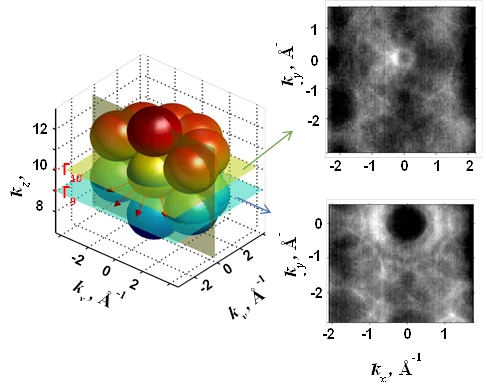Quasicrystals (QCs) are intermetallic alloys where excellent long-range order coexists with lack of translational symmetry in one or more dimensions. These materials have a high potential in application as a material for a solar cells, hydrogen storage applications, heat insulating layers, and others. Researches at the ADRESS beamline of SLS have performed the first observation of the three-dimensional Fermi surface (FS) and valence band dispersions near the Fermi level, determining exotic transport properties of these compounds, in decagonal Al70Ni20Co10 (d-AlNiCo) QCs using soft X-ray angle-resolved photoemission spectroscopy. The enhanced probing depth and sharp definition of 3D electron momentum achieved with this novel and technically challenging spectroscopic technique have for the first time allowed disentanglement of electron dispersions in the periodic and quasiperiodic planes of d-AlNiCo. The results show that the experimental FS (see the figure) formed by dispersive Al sp-states, has a multicomponent character due to a large contribution from high-order bands. More importantly, the magnitude of the gap at the FS related to the band interaction at the Brillouin zone boundary (Hume–Rothery gap) critically differs for the periodic and quasiperiodic directions. The Hume-Rothery mechanism is believed to play a crucial role in stabilization of QCs, typically providing a pseudogap of 1-eV-order at the Fermi level. The current experiment has demonstrated that the expected Hume-Rothery gap occurs along the periodic directions in d-AlNiCo, but along the quasiperiodic directions such gap is vanishingly small. These pioneering experimental results suggests that energetic mechanisms beyond the standard Hume-Rothery picture may also play an important role in the QC structure stabilization. This discovery has been published in the October issue of Nature Communications.
Original Publication
Fermi states and anisotropy of Brillouin zone scattering in the decagonal Al–Ni–Co quasicrystalV. A. Rogalev, O. Gröning, R. Widmer, J. H. Dil, F. Bisti, L. L. Lev, T. Schmitt & V. N. Strocov.
Nature Communications 6, Article number: 8607, Published 07 October 2015, DOI: 10.1038/ncomms9607
Contact
V. N. StrocovLaboratory for Synchrotron Radiation — Condensed Matter Physics
Swiss Light Source, Paul Scherrer Institute
5232 Villigen PSI, Switzerland
Phone: +41 56 310 5311, e-mail: vladimir.strocov@psi.ch
